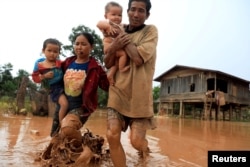Samled Inthavong had almost finished hoisting his family members into a boat when a building uprooted by the collapse of a dam upstream slammed into his house.
Bobbing atop the surging floodwaters in the inky midnight darkness, he could only watch as his house caved in on his grandparents trapped inside.
“My grandparents couldn’t move. They died in the house,” he said in a rescue center where he sat with his few remaining possessions, including a photo of his grandmother Chanthai shot on a mobile phone.
As his house collapsed, Inthavong’s boat shot away and collided with his sister’s adjacent house. There he, his wife, Bang Helmani, and his children Alik, Had and Koid, took refuge on the roof until the rising floodwaters, which reached more than 10 meters, swallowed her home as well.
“At 2 o’clock [a.m.] I was looking around the neighborhood. People were crying and the water was over the whole village. All the houses were gone. Some people were holding on to trees, some people were holding on to power poles,” he said.
Inthavong and his family made for the latter, clutching desperately to the steel structure as flying debris and violent tides crashed beneath them. It wasn’t until morning that a rescue boat arrived in Ban Mai village.
WATCH: Survivors Recount Horror of Lao Dam Collapse
Thousands rescued
Lt. Col. Khamsouk Khamleuangthep, vice commander of the Lao Air Force’s Air Regiment 703, commanded the rescue team that saved Inthavong’s family and more than 1,000 others after a poorly constructed auxiliary dam collapsed at the Xe Pian Xe Namnoy (PNPC) hydropower complex in southern Laos on July 23.
Thirteen villages were inundated in Attapeu province with a surge so powerful it forced the evacuation of a town more than 100 kilometers downstream in Cambodia.
“In that time we found people in the trees. After that we took a boat from Sanamxai [rescue base] to collect the people in the trees,” Khamleuangthep said.
Heavily restricted by rough weather, the regiment’s three helicopters had flown 157 missions supported by boats as of Tuesday, rescuing 1,569 survivors, he said. There are more than 6,500 survivors in temporary shelters spread across five rescue bases with almost 3,500 at Sanamxai alone, the district government says. In total, officials say 7,095 people have been displaced in Laos, with 13,067 affected in some way. State media report 35 dead and 99 missing.
“I am really upset about this and I’ve been working from the beginning until now without stopping and I’m very happy to be helping the people,” Khamleuangthep said.
Trauma, exhaustion, fury
The survivors he has rescued feel a mixture of trauma, exhaustion and fury.
Sommay Keosuvanh, a 60-year-old villager from Ban Mai, said the company operating the dam, the South Korean firm SK E&C, had told his community a large volume of water was being released but failed to warn of a possible collapse.
“When the water came, it came quick like a tsunami and people were scared,” he said, adding that the initial surge through his village was at least a meter high. Keosuvanh said the floodwaters destroyed 95 percent of the homes in the village.
Others interviewed by VOA in Ban Mai said the local chief broadcast a warning over loudspeakers that also failed to say anything about a collapse.
SK E&C, which is building the dam through a joint venture with PNPC, declined multiple requests for comment including some made during visits directly to their field office.
But after staying tight-lipped in the immediate aftermath of the disaster, the Laos government this week said SK E&C’s shoddy construction was likely to blame for the collapse.
It also announced a wide-ranging review of some 50 hydropower projects before any more are approved. This follows years of criticism from conservation groups over the government’s ambitious plan to use its hydroelectric potential to turn the country into the “battery of Asia.”
Little consolation
That’s little consolation for the residents of Ban Mai and Kokkong, whose villages have been leveled, leaving a tangled mess of smashed concrete, uprooted trees and fallen power poles.
On either side of the submerged road connecting them, fields as far as the eye can see are caked in thick mud, ruined for this year’s harvest.
Some of those who are lucky enough to still have a house, like 38-year-old shopkeeper Sovampheng, have begun returning to see what they can salvage from the mud.
“After spending the second night on the roof I moved to Ban Bok village and somebody came to steal from my shop in the evening by entering from the roof,” she said, rummaging through her damaged stock with her 14-year-old daughter Phutdavenh.
Sovampheng said she and her husband were forced to come back and sleep on the roof of their house in Kokkong village to make sure thieves didn’t loot what little they have left.
“I’m feeling very sad as I just bought new supplies for my shop and I lost everything,” she said.
Her daughter Phutdavenh was playing with her phone in bed when the water surged in.
“I felt very scared. I had never seen something like this before. It was so dangerous,” she told VOA.
Back at the Sanamxai camp, six bodies are doused in kerosene and burned at a mass cremation while survivors like Inthavong wait to find out what the government will do for them.
Inthavong will have to wait for another cremation; the body of his grandfather Phan still hasn’t been found.













